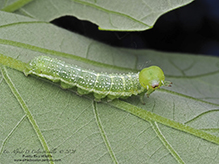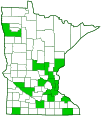ashen pinion
(Lithophane antennata)
Conservation • Description • Habitat • Ecology • Distribution • Taxonomy
|
||||||||
| Hodges # | 9910 |
|||||||
Conservation Status |
||||||||
| IUCN Red List | not listed |
|||||||
| NatureServe | NNR - Unranked SNR - Unranked |
|||||||
| Minnesota | not listed |
|||||||
Description |
||
Ashen pinion is an early and late season, medium-sized moth. It occurs in the United States and southern Canada east of the Great Plains. It is not uncommon in Minnesota. The larvae feed on the leaves of many species of trees and shrubs, including apple, ash, cherry, crabapple, elm, hickory, maple, oak, peach, pear, plum, and willow. Adults are found from late September to November in deciduous woodlands and forests and in fruit orchards. They overwinter and are active again the following spring from late March to early June. Adults are thick bodied and ⅞″ to 1″ (23 to 25 mm) in length and have a 1⅜″ to 1⅝″ (35 to 42 mm) wingspan. The forewings are pale to medium gray. The usual lines are present, but they are thin, blackish, and inconspicuous. The subterminal line is represented by a row of dark wedge-shaped spots. There is a large pale spot in the basal area on the leading edge (costal margin). It is bordered on the inside with a thin black line. There are three conspicuous spots in the median area, all of them bordered with a black line. The large spot (orbicular spot) in the upper median area near the costal margin is shaped like a sideways hourglass or like two spots joined together. It is pale gray and usually has some darker gray shading in the center of each of the two lobes. The small spot (claviform spot) between the orbicular spot and the inner margin is wedge shaped. It is sometimes light gray, sometimes dark gray. The black border is often inconspicuous. Sometimes the outline and fill are similar to the background color, making the entire spot inconspicuous. The large kidney-shaped spot (reniform spot) in the lower median area is gray with a large light brown area in the center and a small black area near the inner edge. The hindwing is grayish brown. The caterpillar, called widestriped green fruitworm, is less than 1 9⁄16″ (4 cm) in length. It is green and somewhat shiny, with several stripes and spots. The middle (middorsal) stripe is cream colored, thin, and continuous from the second segment of the thorax to the last segment of the abdomen. The subdorsal stripe is white and is broken into a line of spots. On each abdominal segment there is a pair of round, well defined, white spots between the middorsal stripe and each subdorsal stripe. The supraspiracular stripe is represented by white, more widely spaced spots that weakly define a line. The stripe through the breathing pores (spiracular stripe) is broad and continuous. This stripe is what gives the caterpillar its common name. Though called a fruitworm, the caterpillar only occasionally eats developing fruit. |
||
Size |
||
Total length: ⅞″ to 1″ (23 to 25 mm) Wingspan: 1⅜″ to 1⅝″ (35 to 42 mm) |
||
Similar Species |
||
Habitat |
||
Deciduous woodlands and forests and in fruit orchards |
||
Ecology |
||
Season |
||
One generation per year: late September to November and late March to early June |
||
Behavior |
||
|
||
Life Cycle |
||
Adults overwinter |
||
Larva Food |
||
Leaves of many species of trees and shrubs, including apple, ash, cherry, crabapple, elm, hickory, maple, oak, peach, pear, plum, and willow. |
||
Adult Food |
||
Flower nectar |
||
Distribution |
||||
|
Sources Biodiversity occurrence data published by: Minnesota Biodiversity Atlas (accessed through the Minnesota Biodiversity Atlas Portal, bellatlas.umn.edu, 12/1/2023). |
|||
| 12/1/2023 | ||||
Occurrence |
||||
Not uncommon |
||||
Taxonomy |
|||
Order |
Lepidoptera (Butterflies and Moths) | ||
Superfamily |
Noctuoidea (Owlet Moths and Allies) | ||
Family |
Noctuidae (cutworm moths and allies) | ||
Subfamily |
Noctuinae (cutworms and dart moths) | ||
Tribe |
Xylenini (swordgrasses, pinions, and xylenine sallows) | ||
| Subtribe | Xylenina | ||
Genus |
Lithophane | ||
| Section | Lithophane antennata (ashen pinions and allies) | ||
Synonyms |
|||
Lithophane cinerea Xylina antennata |
|||
Common Names |
|||
ashen pinion ashen pinion moth widestriped green fruitworm (larva) |
|||
Glossary
Claviform spot
A club-shaped, wedge-shaped, or round spot in the upper median area, between the orbicular spot and the inner margin, connected to the AM line, on the forewing of many moths.
Costal margin
The leading edge of the forewing of insects.
Orbicular spot
A circular spot or outline in the upper median area near the antemedial line on the forewing of many moths.
Reniform spot
A kidney-shaped spot or outline in the lower median area near the PM line on the forewing of many moths.
Spiracle
A small opening on the surface of an insect or arachnid through which it breathes.
Visitor Photos |
|||||
Share your photo of this insect. |
|||||
| This button not working for you? Simply email us at info@MinnesotaSeasons.com. Attach one or more photos and, if you like, a caption. |
|||||
Alfredo Colon |
|||||
 |
|||||
MinnesotaSeasons.com Photos |
|||||
|
|||||

Slideshows |
||

Visitor Videos |
|||
Share your video of this insect. |
|||
| This button not working for you? Simply email us at info@MinnesotaSeasons.com. Attach a video, a YouTube link, or a cloud storage link. |
|||
Other Videos |
|||

Created: 12/1/2023
Last Updated:


